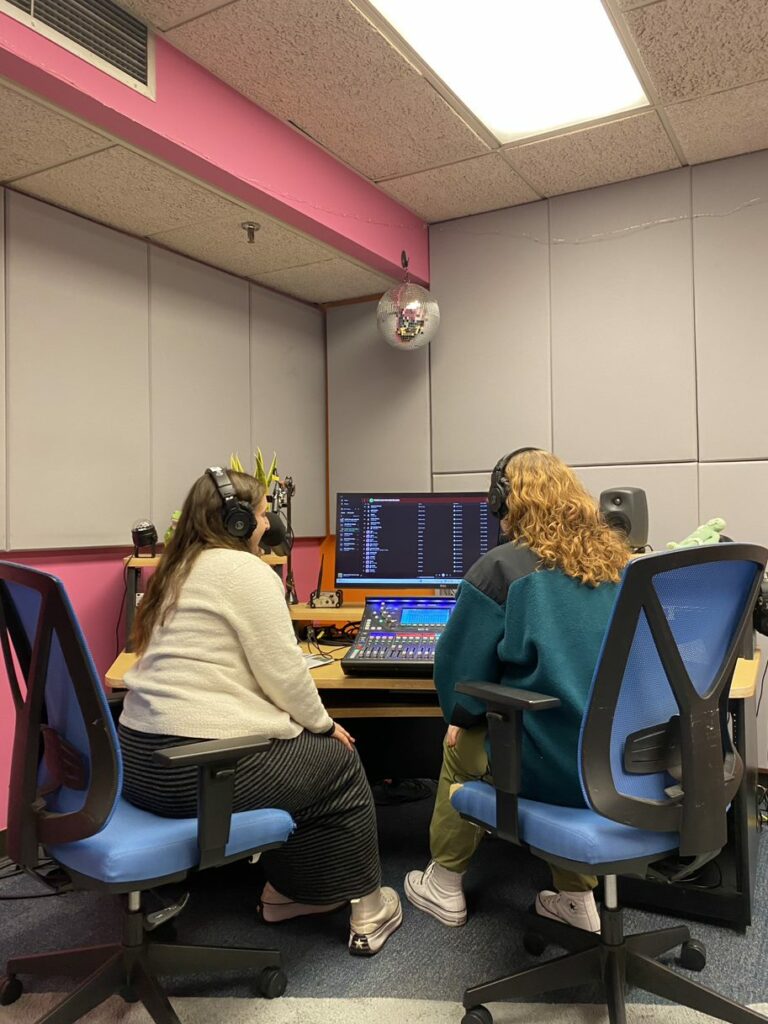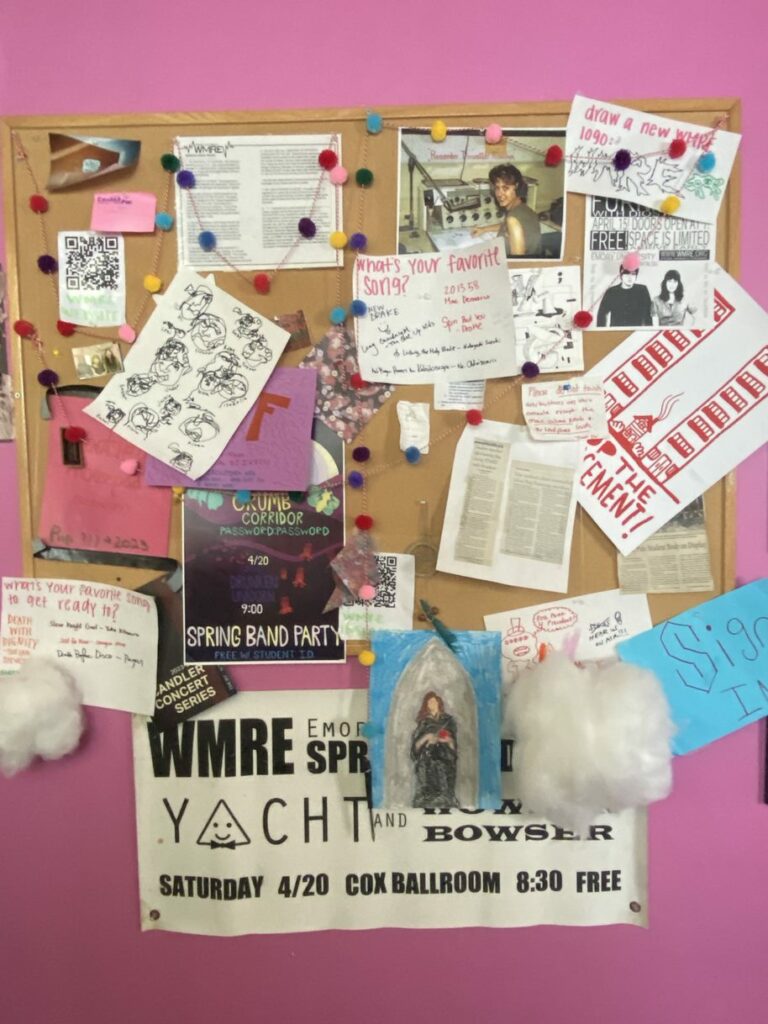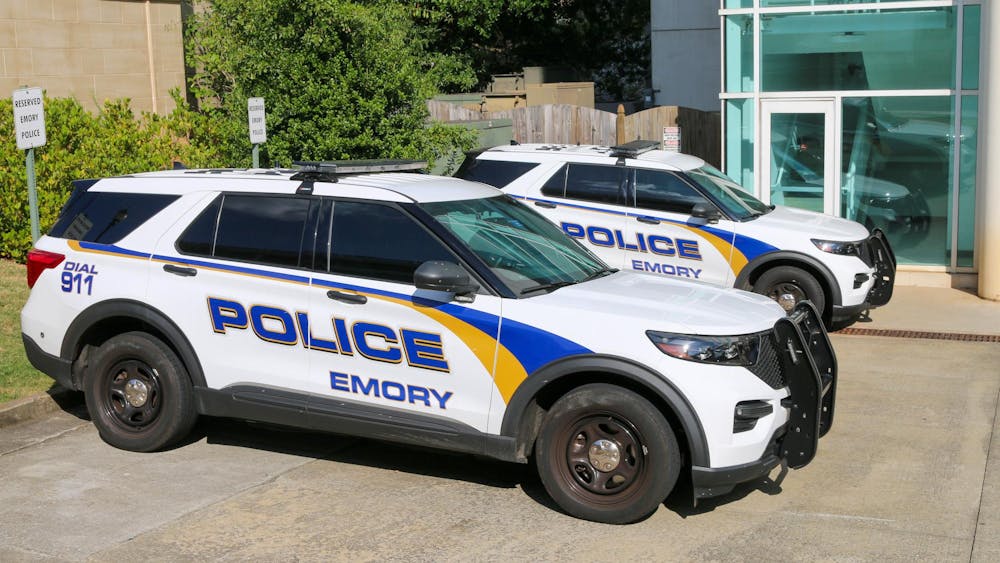 (Catherine Goodman/Assistant Arts & Life Editor)
(Catherine Goodman/Assistant Arts & Life Editor)
On the fourth floor of the Alumni Memorial University Center, a flier-plastered door creaks open to reveal Emory University’s student-run radio station. WMRE’s pink walls are crowded with homemade decor. Newly-installed disco balls rest on the audio-mixer, and the room bursts with color under LED lights. The new decorations revamp the space, ushering in the next era of WMRE.
The outbreak of the COVID-19 pandemic forced the station’s members to haphazardly abandon the room, leaving a mess for the next generation to clean up. WMRE General Manager Ruby Stillman (24C) said the former students left the “on-air” light on when they were forced to leave campus. The light burned for a year straight, waiting for WMRE’s uncertain return.
History of WMRE
WMRE first began broadcasting in 1989 via a carrier current system that strictly allowed for on-campus listeners. After the system deteriorated, the station broadcasted to on-campus listeners through Emory Cable Television. The organization did not hit the internet until 1998, when they adopted RealAudio and RealVideo. Now, WMRE streams online, enabling the station to reach a worldwide audience.
As the station transitioned from the cable system to the internet in 1998, WMRE established a strong presence on campus. The station frequently hosted local musicians, obtained press packets from big names and maintained connections with Atlanta venues, according to former WMRE member April Compingbutra (02C, 07PH).
“It was absolutely fantastic,” Compingbutra said. “We had Ludacris. We had Mastodon. We had OutKast. It was a big deal.”
Compingbutra hosted a radio show called “Disregarded Subcultures” as an undergraduate student. The show focused on goth, synthetic and experimental music.
“Even if it was an opera singer screeching or trying new things with their vocals, I would totally put that on there,” Compingbutra said.
Due to the technology available at the time, being a disk jockey (DJ) required a considerable amount of legwork, according to Compingbutra. To include music in a radio show, DJs had to call their favorite bands to ask for material to play and lug big cases of CDs to the station.
However, Compingbutra expressed gratitude for her time at WMRE. Not only did she discover new artists and genres, but she also made friends that she maintains today.
“It’s personal, and yet it is also very, very shared,” Compingbutra said. “That’s why it totally matters, especially on a campus. That’s the easiest way to make community right there — through a song.”
The presence of WMRE continued into the 2000s, when the station broadcasted via both the internet and Emory Cable Television, which contained channels with student programming, movies and Emory Television projects. Students could watch WMRE DJs live through a small camera in the corner of the studio, according to Emory Visual Arts Program Director Dana Haugaard (03Ox, 05C).
WMRE was the “soundtrack” of Haugaard’s college days. His dorm room TV often played the station to accompany group hang-outs, and he lamented that WMRE is not as widely known or appreciated today. Haugaard suggested that the popularity of the station in the early 2000s resulted from a different type of student body — a grungier kind. As Emory’s academic prowess has risen over the years, Haguaard said the creativity of the campus has fallen.
“It was not as hard of a school to get into then, and I think Emory’s recruitment missions were a little different,” Haguaard said. “There was more space for goofballs and weirdos and art kids … And the Venn diagram of art kids and the WMRE kids, there’s a pretty big overlap.”
Nevertheless, Haugaard said he believes in the future of WMRE and the positive presence the organization brings to campus.
“There’s room to grow,” Haguaard said. “I’m sure they’re working on it.”
 (Catherine Goodman/Assistant Arts & Life Editor)
(Catherine Goodman/Assistant Arts & Life Editor)
Rebuilding WMRE
During the COVID-19 pandemic, the station shut down completely. As a senior, Stillman witnessed the organization’s struggle first-hand.
“It used to be — before my time here — a big, big club,” Stillman said. “It had its own house, and they would do shows there. A lot of people knew about WMRE — and then COVID happened.”
The club was barely functioning post-pandemic, Stillman said. The executive board lost access to the studio and could not log into the computer or Instagram account. When Stillman hosted a radio show her sophomore year, the technology was inconsistent, and the stream often failed. The pre-pandemic members had graduated, and the previous advisor had relinquished the position, leaving the remaining members without guidance and the studio in “complete disarray,” Stillman said.
Unable to watch the deterioration of WMRE, Stillman stepped into the role of vice president her junior year and general manager her senior year. She asked Senior Vice President and Dean of Campus Life Enku Gelaye for help, and Gelaye assigned the organization a new advisor, Paul Eleazer, who then conceded the position to Mardy Beeson. Beeson had worked for Turner Broadcasting for 40 years before serving as the equipment loan desk manager for Emory’s Visual Arts Building.
Beeson serves multiple roles for WMRE staff, including advisor, friend, technology engineer and one of the station’s biggest fans. He knows the radio shows by name and can recite the station’s schedule, listening to their music at work, in his car and at home. Last year, WMRE purchased a new mixing board as part of their revival campaign, only to find the technology not quite right for their shows. Beeson fixed the mess.
“I took their mixing board — the brand new one in the box — to my house, and I set it on my kitchen table for a month, where I built a radio station-like program into this console,” Beeson said.
Stillman and WMRE Assistant General Manager Oli Turner (25C) spearheaded the wholescale reinvigoration of the organization. The club began working to reestablish their on-campus presence in August 2023, according to WMRE Zine co-Manager Klara Nitsche (24C). She explained that their goal is to carve out a new space for alternative groups of students and foster a community of acceptance.
To regain their prominence on campus, WMRE adopted a number of advertisement strategies, according to WMRE Campus Engagement co-Manager Gabe Marrero (26C) and former WMRE Campus Engagement co-Manager Chayse Corfman (25B). They hosted events such as music bingo nights, hung posters on public boards and decorated the campus with funky chalkings. The club created a new logo and emphasized their online presence.
Last semester, Marrero andCorfman (25B) led the work to increase general interest in the club while also establishing bonds within the executive board.
“We are a community in our own sense, but we are also bridging other communities,” Marrero said.
WMRE Creative Board co-Director Alexia Brown (24C) attributed their 2023 resurgence to their rebranding efforts, but she also noted that the executive board made sacrifices, such as switching to only streaming online.
“We had a lot of long and tough conversations about if we wanted to continue as a typical radio station,” Brown said. “We decided it was best for everybody to get with the changing times, and I think it’s being successful.”
Reflecting on her time at the station, Stillman said she has dedicated many years of her life to bringing WMRE back to the forefront.
“I didn’t let it die; I revived it,” Stillman said. “It’s like a Frankenstein club.”
 (Catherine Goodman/Assistant Arts & Life Editor)
(Catherine Goodman/Assistant Arts & Life Editor)
College radio at Emory
Even if transmitter radio has lost its prominence in modern culture, the WMRE executive board, including Technology Director Jackie Hampton (26C), believe the medium has unparalleled importance on college campuses.
“Student radio is such a fun and young thing to do,” Hampton said. “It’s just a healthy reminder that we’re still kids, and you can have fun and be kind of punk.”
Emory students struggle with doing something purely for fun, not for personal or professional gain, Hampton added. Surrounded by the University’s intense pre-professional culture, Hampton said the arts may seem trivial or unimportant, with Nitsche noting a “severe lack of authentic student shenanigans” at Emory.
WMRE, however, encourages these alternative routes of expression. Marrero and Corfman believe that the station’s openness sets it apart from other clubs at Emory. Non-academic, non-competitive and non-exclusive clubs are unusual on campus, Corfman noted.
“It’s just such a great space because it does feel like there’s no strings attached,” Corfman said. “You’re not trying to get anything out of it; you’re just trying to have fun.”
WMRE Media Operations co-Director Jaden Ellman (24C) and former WMRE Media Operations co-Director Kiran Berger (25B) expressed a similar sentiment, highlighting the club’s role on campus as a safe space for artists and art appreciators alike.
“STEM is such a big part of the culture here, and the arts tend to get a little overlooked,” Ellman said. “Maintaining that kind of space for student artists, or really any student interested in the art world, that’s more crucial than ever here.”
WMRE finished last semester with 111 DJs and 64 shows per week. Even as the rain washes away their chalkings on Asbury Circle, and the posters in Kaldi’s Coffee are buried under new flyers, the station never stops playing.
“Turn us on,” Berger said, reciting WMRE’s slogan.
Managing Editor Oli Turner (25C) is the assistant general manager of WMRE and had no role in writing or editing this article.









